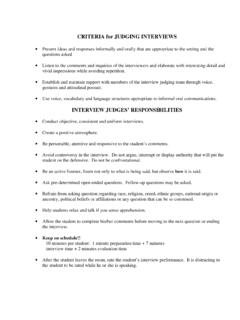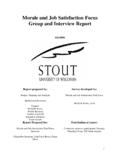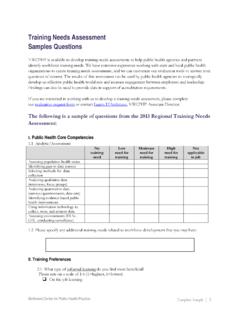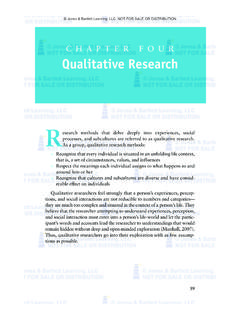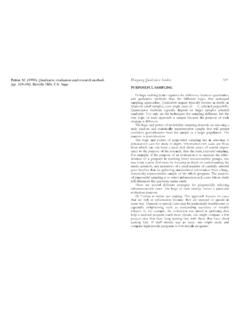Transcription of HOW TO ORGANISE AND RUN FOCUS GROUPS
1 HOW TO ORGANISE AND RUN FOCUS GROUPS BACKGROUND FOCUS GROUPS can form an important part of the process of using the Management Standards to assess and control risks related to work-related stress.
2 FOCUS GROUPS are basically: Ways of listening to employees and learning from them; One way of facilitating active participation of employees in the risk assessment process for work-related stress; and One way for management to demonstrate commitment to a participative process of managing the risks from work-related stress. PURPOSE The purpose of using FOCUS GROUPS is to discuss the findings from Step 2 of the risk assessment process (survey results, absence data, etc) with a sample of employees and to elicit suggestions for improvement. Employees can draw on their own detailed knowledge of local and contextual factors to: Uncover the underlying causes of any undue pressure in their work; Enrich interpretation of the data collected at Step 2 of the process the HSE Analysis tool, other surveys, sickness absence data, exit interviews, etc.
3 Identify local issues; Prioritise the specific areas in which there is a need for action; Explore practical and workable improvements In our experience, of working with organisations using the Management Standards approach, steps 2 and 3 seem to generate the most challenges. In that, some organisations find it difficult to effectively form data collection and analysis (Step 2) through FOCUS GROUPS (Step 3) to the generation of and implementation of action plans (Step 4). Some common errors we have encountered is that organisations either try to circumvent Step 3, moving directly from data analysis to action planning, or alternatively, make Step 3 overly complex generating very detailed and exhaustive action plans that are very difficult to implement.
4 The true purpose of Step 2 and Step 3 is to enable the organisation to identify the key issues and work with their employees to develop appropriate interventions (actions). The role of the steering group will be to combine the FOCUS group information with results gathered from Step 2 analysis tool data, other surveys, and sickness absence data, etc. The main issues and solutions that arose at overall and local level will be then summarised and prioritised. In deciding what actions to include on the action plan the following aspects need to be considered: What action is the organisation already taking?
5 Is it enough? In order to help answer this question the states to be achieved should be revisited. What more does the organisation need to do? STEP-BY-STEP
6 GUIDE TO RUNNING FOCUS GROUPS PREPARING FOR THE FOCUS group Developing a question set The data gathered in Step 2 of the process should have highlighted a number of areas warranting further exploration. Therefore, it is advised to base the question set on these areas. The HSE Analysis Tool or other survey tools may have indicated that for example employees poorly perceive 'Demands'. The question set may then contain questions to unravel causes of undue pressure asking FOCUS group participants to comment on priorities and time pressures. The question set can also FOCUS on the sickness absence data trends.
7 After exploring the issues, it is important to remember to elicit some practical and workable improvements from participants. A pre-prepared schedule of questions can: Help ensure each group is given adequate opportunity to discuss all the key issues in a similar fashion; Be helpful if the facilitator has been drafted in from outside and is unfamiliar with your unit or section of the organisation; Help the facilitator to stay on track and on time Types of Questions Remember that you are not merely seeking oral responses to a questionnaire, it is important to encourage open exchanges and discussion.
8 As part of your preparation you should FOCUS on how to introduce questions and topics in a conversational manner. The set of questions should include: Introductory questions: Questions should be designed to get participants discussing the issue of work-related stress in general before homing in on particular issues Linking questions: Questions which enable the facilitator to move from the broad general discussion, following the introductory question, to the more specific areas of interest; Key questions: Questions which address the key issues which the facilitator wants to cover in the FOCUS group session.
9 See Appendix 1 Using questions in FOCUS GROUPS for more detailed information on the types of questions you can use. Number of questions A rule of thumb is that you will have time for no more than four or five key questions in a FOCUS group lasting to 2 hours. Statement on future action It is helpful to include at the end of your question schedule a prepared statement on what will happen next, for example: How results will be summarised, interpreted and reported; What other specific actions will be taken; The timescales for reporting and subsequent action; How
10 Participants will be kept informed of progress. Developing a method to record the data Before the FOCUS GROUPS begin it is worthwhile to consider how the discussions are to be recorded and how they will be analysed. One way is to produce a template for the facilitators to complete at the end of the session. Planning and timetable It is important at the start of the process to plan the FOCUS group sessions into the project plan. Selecting the group The number of FOCUS GROUPS and employees involved in this stage will depend on the size of the organisations, the organisational structure and local circumstances.












